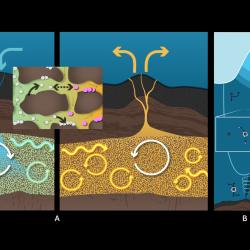UMD Geology Ph.D. Student Helps Discover Giant Volcano on Mars
The discovery brings scientists closer to finding possible extraterrestrial life on Mars and provides a potential destination for future robotic and human exploration.
Researchers announced the discovery of a deeply eroded volcano near Mars’ equator on March 13, 2024, at the 55th Lunar and Planetary Science Conference. The volcano, which the scientists tentatively named “Noctis volcano,” is located in the eastern part of Mars’ Tharsis province—a region that contains three of the planet’s biggest volcanoes.

According to the researchers, including University of Maryland geology graduate student Sourabh Shubham, the structure was deeply eroded beyond easy recognition and hidden in plain sight for decades after its first imaging by orbiting spacecraft in 1971. Combined with the potential presence of a buried glacier ice sheet near it, the volcano has profound implications in the search for life beyond Earth.
“It’s really a combination of things that makes the Noctis volcano site exceptionally exciting,” said the study’s lead researcher Pascal Lee, a planetary scientist with the SETI Institute and Mars Institute, based at NASA Ames Research Center. “It’s an ancient and long-lived volcano so deeply eroded that you could hike, drive or fly through it to examine, sample and date different parts of its interior to study Mars’ evolution through time.”
Lee and Shubham initially identified this volcano while examining the geology of an area where they previously found the remains of a glacier last year. Located just south of Mars’ equator, the volcano reaches over 29,600 feet in elevation and spans over 280 miles in diameter. Its gigantic size and complex modification history indicate a long and tumultuous past, possibly from a combination of fracturing, thermal erosion and glacial erosion.
The researchers theorize that the Noctis volcano was created through accumulations of pyroclastic matter (rocks ejected from explosive volcanic eruptions), lavas and ice before it lost the stereotypical volcanic cone shape via extensive tectonic activity. As fractures and faults developed, lavas began to rise, contributing to the loss of vast amounts of buried ice and the catastrophic collapses of entire sections of the volcano. Remnants of the original volcanic structure were found in the site’s perimeter, including lava flows, volcanic particulate materials (ash, cinders, pumice) and hydrated mineral deposits. Those types of deposits usually occur during high rates of evaporation of water in warm settings.
“This area of Mars is known to have a wide variety of hydrated minerals spanning a long stretch of Martian history. A volcanic setting for these minerals had long been suspected. So, it may not be too surprising to find a volcano here,” explained Shubham, co-author of the study and the researcher who connected the hydrated minerals to possible volcano-ice interactions at this site. “In some sense, this large volcano is a long-sought ‘smoking gun.’”
In addition to the volcano, the study reports the discovery of a large, approximately 2,000-square-mile area of volcanic deposits within the volcano’s perimeter. This “blistered terrain” appears as many low and rounded blister-like mounds. The researchers describe the region as a field of “rootless cones” created by explosive steam venting or steam swelling when a thin blanket of hot volcanic matter comes to rest atop water or an ice-rich surface. Lee and Shubham suggest that ice might still be preserved under the volcanic blanket.
However, much about this newly discovered volcano remains a mystery. Although it’s clear that the volcano has ancient origins, scientists remain uncertain of how long ago it first developed. Similarly, despite research indicating that Noctis volcano has erupted relatively recently in Mars’ history, it’s unknown if the volcano remains active or when it may erupt again.
Still, even as mysteries like these continue to puzzle scientists, the Noctis volcano is already emerging as an exciting new location to study Mars’ geologic evolution and continue the search for life beyond Earth. Lee and Shubham believe that the possible presence of glacier ice at shallow depths near the Martian equator means that humans could potentially explore a less frigid part of the planet while being able to extract water for hydration and rocket fuel production by breaking down water into hydrogen and oxygen molecules.
“[The region] has had a long history of heat interacting with water and ice, which makes it a prime location for astrobiology and our search for signs of life,” Lee said. “Finally, with glacier ice likely still preserved near the surface in a relatively warm equatorial region on Mars, the place is looking very attractive for robotic and human exploration.”
This study was conducted using data from NASA’s Mariner 9, Viking Orbiter 1 and 2, Mars Global Surveyor, Mars Odyssey, and Mars Reconnaissance Orbiter missions, as well as ESA’s Mars Express mission.
###
This article was adapted from text provided by the SETI Institute.
This work was supported by the SETI Institute, the Mars Institute and NASA. This story does not necessarily reflect the views of these organizations.
The study, “Large eroded volcano complex and buried glacier ice in Eastern Noctis Labyrinthus: evidence for recent volcanism and glaciation near Mars’ equator,” was presented at the 55th Lunar and Planetary Science Conference held March 11-15, 2024.







